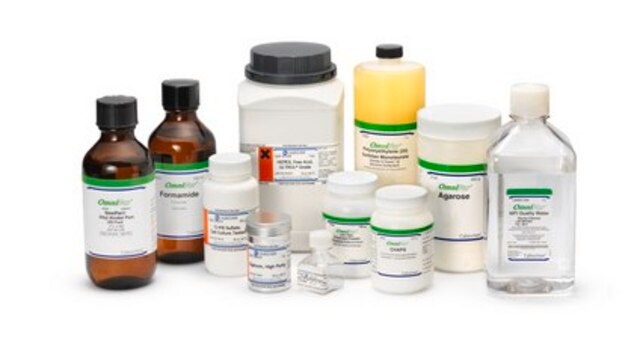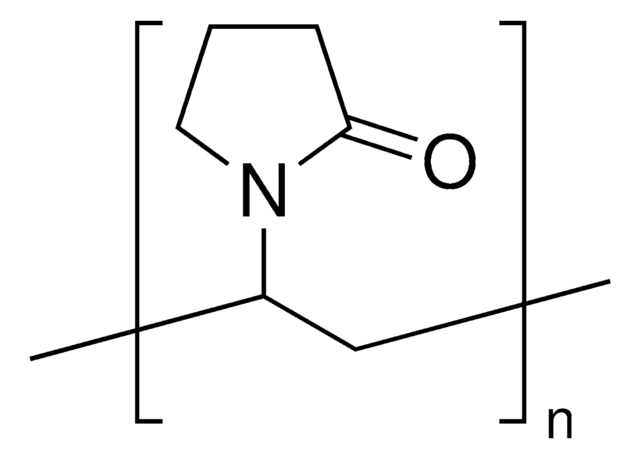PVP10
Polyvinylpyrrolidone
average mol wt 10,000
Synonym(s):
PVP, Polyvidone, Povidone
Sign Into View Organizational & Contract Pricing
All Photos(4)
About This Item
Linear Formula:
(C6H9NO)n
CAS Number:
MDL number:
UNSPSC Code:
12352100
PubChem Substance ID:
NACRES:
NA.21
Recommended Products
form
powder
Quality Level
mol wt
average mol wt 10,000
viscosity number
12-18(lit.)
SMILES string
C=CN1CCCC1=O
InChI
1S/C6H9NO/c1-2-7-5-3-4-6(7)8/h2H,1,3-5H2
InChI key
WHNWPMSKXPGLAX-UHFFFAOYSA-N
Looking for similar products? Visit Product Comparison Guide
Related Categories
General description
Polyvinylpyrrolidone (polyvidone, povidone, or PVP) is a synthetic water-soluble polymer consisting of linear 1-vinyl-2-pyrrolidinone groups. It is hygroscopic and readily absorbs up to 40% of water by its weight. It has excellent wetting properties in solution and easily forms films, which makes it suitable for use as a coating additive.PVP can be synthesized from its monomer N-vinylpyrrolidone via free-radical polymerization in the presence of AIBN as an initiator. In chemical industries, PVP is widely used as a surface stabilizer, growth modifier, nanoparticle dispersant, and reducing agent.
PVP can serve as a surface stabilizer, nanoparticle dispersant, growth modifier, and reducing agent, depending on the synthetic conditions.
PVP can serve as a surface stabilizer, nanoparticle dispersant, growth modifier, and reducing agent, depending on the synthetic conditions.
Application
PVP (average mol wt 10,000) can be used as a stabilizing agent in the synthesis of metal nanoparticles to prevent them from agglomeration. PVP is also used in the fabrication of mesoporous silica-polymer hybrid (PVP-aminopropyl-SBA-15 Schiff Base hybrid) for the effective removal of divalent heavy metal cations from wastewater. Grafting of PVP functionalization offers a strong affinity for heavy metal ions because it provides two adsorption sites, one through metal-C-O group interaction and the other through metal-π interaction (the chelation of with Schiff base).
Other Notes
Polyvinylpyrrolidone is a component of Denhardt′s Solution and is included at a concentration of 1% (w/v) in the standard 50X stock solution.
Storage Class Code
11 - Combustible Solids
WGK
WGK 1
Flash Point(F)
Not applicable
Flash Point(C)
Not applicable
Personal Protective Equipment
dust mask type N95 (US), Eyeshields, Gloves
Choose from one of the most recent versions:
Already Own This Product?
Find documentation for the products that you have recently purchased in the Document Library.
Customers Also Viewed
Guanghua Luo et al.
International journal of medical sciences, 11(10), 1015-1021 (2014-08-20)
Apolipoprotein M (APOM) has been suggested as a vasculoprotective constituent of high density lipoprotein (HDL), which plays a crucial role behind the mechanism of HDL-mediated anti-atherosclerosis. Previous studies demonstrated that insulin resistance could associate with decreased APOM expressions. In agreement
Adam Healey et al.
Plant methods, 10, 21-21 (2014-07-24)
Next-generation sequencing technologies rely on high quality DNA that is suitable for library preparation followed by sequencing. Some plant species store large amounts of phenolics and polysaccharides within their leaf tissue making genomic DNA extraction difficult. While many DNA extraction
Haifang Yang et al.
Horticulture research, 5, 23-23 (2018-05-08)
Litchi is one of the most important subtropical evergreen fruit trees in southern Asia. Previous studies indicated that high-temperature conditions encourage growth of rudimentary leaves in panicles and suppress flowering. We have demonstrated that methyl viologen dichloride hydrate (MV) and
Zhe Gao et al.
Advanced science (Weinheim, Baden-Wurttemberg, Germany), 7(4), 1901624-1901624 (2020-02-27)
Cryopreservation technology allows long-term banking of biological systems. However, a major challenge to cryopreserving organs remains in the rewarming of large volumes (>3 mL), where mechanical stress and ice formation during convective warming cause severe damage. Nanowarming technology presents a
Kallum M Koczkur et al.
Dalton transactions (Cambridge, England : 2003), 44(41), 17883-17905 (2015-10-06)
Colloidal synthesis offers a route to nanoparticles (NPs) with controlled composition and structural features. This Perspective describes the use of polyvinylpyrrolidone (PVP) to obtain such nanostructures. PVP can serve as a surface stabilizer, growth modifier, nanoparticle dispersant, and reducing agent.
Our team of scientists has experience in all areas of research including Life Science, Material Science, Chemical Synthesis, Chromatography, Analytical and many others.
Contact Technical Service

